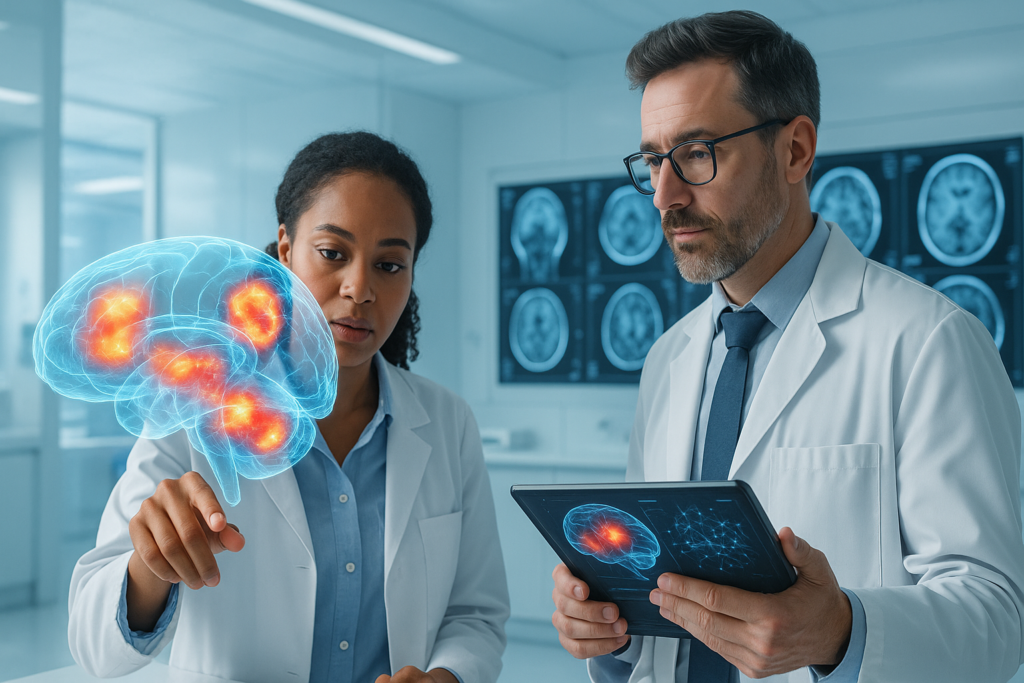The Impact of Generative AI in Radiology and Medical Imaging
Table of Contents
Introduction
The world of medical imaging is undergoing a profound transformation, thanks to the rise of Generative AI (GenAI). Once limited to analyzing images, AI is now creating, enhancing, and interpreting medical scans with speed and precision never seen before. In radiology, where time and accuracy can determine life-or-death outcomes, generative AI is becoming a game-changer.
This blog explores how GenAI is reshaping radiology workflows, accelerating diagnoses, improving image quality, and setting new standards in patient care.
What Is Generative AI in Medical Imaging?

Generative AI refers to a class of machine learning models that can generate new data from existing patterns. In medical imaging, GenAI is used to:
- Reconstruct low-resolution or noisy scans into clearer images
- Fill in missing or corrupted scan data
- Generate synthetic training data for model development
- Simulate disease progression over time
- Enhance 3D visualization for surgical planning
Popular GenAI models include GANs (Generative Adversarial Networks) and Diffusion Models, now being tailored for healthcare applications.
How Radiology Benefits from GenAI
- Image Reconstruction & Enhancement: Generative AI can take low-quality scans—such as those captured in emergency or low-resource settings—and reconstruct them into high-resolution images. This is especially impactful for MRI and CT scans, where image clarity directly affects diagnostic accuracy.
- Accelerated Imaging: GenAI models are helping reduce scan time without compromising quality. By reconstructing full images from partial data, patients spend less time inside imaging machines, improving throughput and patient comfort.
- Filling Data Gaps: In cases of motion artifacts, missing slices, or poor contrast, GenAI algorithms can intelligently “fill in” missing data, producing clinically usable results even when conditions aren’t ideal.
- Synthetic Data for Training AI: Medical imaging datasets are often small or biased. GenAI allows developers to generate synthetic but realistic images, improving model generalization and performance in rare disease cases.
Read Also: AI in Marketing: How Generative AI is Reshaping Website Traffic
Applications in the Real World
- Hospitals & Diagnostic Labs: AI-enhanced imaging tools are being integrated into radiology software to pre-process images, flag abnormalities, and prioritize urgent cases for radiologist review.
- Research & Drug Trials: Pharmaceutical companies use GenAI to simulate organ-level changes or track disease progression over time via synthetic imaging—speeding up clinical validation.
- Specialized Radiology: Fields like oncology, cardiology, and neurology are leveraging GenAI to map tumors, blood vessels, and brain lesions in high resolution.
Addressing the Risks
Despite its promise, GenAI in radiology is not without concern:
- Hallucinated Data: AI-generated content may introduce features that don’t exist, risking misdiagnosis.
- Regulatory Oversight: Many GenAI tools are still under review and lack FDA or CE approval for clinical use.
- Bias & Explainability: Like other AI models, GenAI systems may replicate training data biases and are often black boxes.
To safely deploy GenAI in clinical settings, transparency, validation, and human-in-the-loop systems are essential.
Global Adoption & Innovation
Hospitals and research centers in the US, UK, Germany, India, and South Korea are leading in GenAI deployment for radiology. Leading AI-healthtech startups like Viz.ai, Lunit, and DeepHealth are working on FDA-cleared AI platforms that assist radiologists with tumor detection and triage.
Major tech firms like Google Health and NVIDIA Clara are also investing heavily in generative models for diagnostic imaging.
What the Future Holds
In the next 3–5 years, expect:
- AI-enhanced portable imaging for low-resource or rural environments
- GenAI tools integrated with PACS/RIS systems
- Multimodal GenAI combining imaging + clinical notes for richer diagnosis
- Digital twins of organs created using synthetic imaging data
Final Thoughts
Generative AI is ushering in a new era for radiology—one where image quality is enhanced, diagnoses are accelerated, and access is widened. While challenges around validation and transparency remain, the potential benefits to patients, providers, and health systems are enormous.
As radiology embraces AI not just to analyze but to create, the future of medical imaging looks smarter, faster, and more precise than ever before.
Call to Action:
Stay ahead of the AI-medical imaging revolution. Subscribe to iTMunch for the latest on GenAI, diagnostics, and healthtech innovation.





